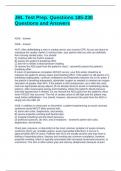JBL Test Prep. Questions 185-230
Questions and Answers
#185: - answer
#186: - answer
#187: After defibrillating a man in cardiac arrest, you resume CPR. As you are about to
reanalyze his cardiac rhythm 2 minutes later, your partner tells you she can definitely
feel a strong carotid pulse. You should:
A) continue with the rhythm analysis.
B) assess the patient's breathing effort.
C) ask her to obtain a blood pressure reading.
D) remove the AED pads from the patient's chest. - answerB) assess the patient's
breathing effort.
If return of spontaneous circulation (ROSC) occurs, your first action should be to
reassess the patient's airway status and breathing effort. If the patient is still apneic or is
breathing inadequately, continue ventilations and frequently reassess his or her pulse. If
the patient is breathing adequately, administer oxygen as needed to maintain an oxygen
saturation of greater than 94%. If the patient is still unresponsive, as is often the case,
insert an appropriate airway adjunct (if not already done) to assist in maintaining airway
patency. After reassessing airway and breathing, obtain the patient's blood pressure
and treat hypotension if needed. Do not remove the AED pads from the patient's chest,
even if ROSC has occurred. The risk of cardiac arrest is still high and the patient may
need further defibrillation. You should, however, disconnect the pads from the AED or
simply turn the AED off.
#188: In addition to chest pain or discomfort, a patient experiencing an acute coronary
syndrome would MOST likely present with:
A) ashen skin color, diaphoresis, and anxiety.
B) severe projectile vomiting and flushed skin.
C) irregular breathing and low blood pressure.
D) profound cyanosis, dry skin, and a headache. - answerA) ashen skin color,
diaphoresis, and anxiety.
Chest pain, pressure, or discomfort is the most common symptom of acute coronary
syndrome (ACS; eg, unstable angina, acute myocardial infarction); it occurs in
approximately 80% of cases. Patients with ACS are usually anxious and may have a
feeling of impending doom. Nausea and vomiting are common complaints; however,
projectile vomiting, which is typically associated with increased intracranial pressure, is
uncommon. The skin is often ashen gray and clammy (diaphoretic) because of poor
, cardiac output and decreased perfusion. Less commonly, the patient's skin is cyanotic.
Respirations are usually unlabored unless the patient has congestive heart failure, in
which case respirations are rapid and labored; irregular breathing, however, is not
common. Blood pressure may fall as a result of decreased cardiac output; however,
most patients will have a normal or elevated blood pressure. If the patient complains of
a headache, it is usually a side effect of the nitroglycerin he or she took before your
arrival; ACS itself usually does not cause a headache.
#189: - answer
#190: In patients with heart disease, acute coronary syndrome is MOST often the result
of:
A) atrial damage.
B) atherosclerosis.
C) coronary artery spasm.
D) coronary artery rupture. - answerB) atherosclerosis.
In most patients with acute coronary syndrome (ACS; eg, unstable angina, acute
myocardial infarction), atherosclerosis is the underlying problem that causes heart
disease. Atherosclerosis is a disorder in which calcium and a fatty material called
cholesterol build up and form a plaque inside the walls of blood vessels, obstructing
blood flow. ACS due to atherosclerosis usually occurs when a fragment of plaque
ruptures and occludes a coronary artery; further occlusion occurs when platelets
aggregate in the area and clump together. Less commonly, acute coronary artery
spasm may result in ACS. The cause of acute coronary vasospasm is largely unknown.
Rupture of a coronary artery is a rare cause of ACS. Atrial or ventricular damage is
usually caused by, rather than the cause of, ACS.
#191: Which of the following describes pulseless electrical activity (PEA)?
A) disorganized, chaotic quivering of the heart muscle that does not generate a pulse
B) The presence of a palpable pulse in the absence of any electrical activity in the heart
C) A rapid cardiac rhythm that does not produce a pulse, but responds to defibrillation
D) Any organized cardiac rhythm, slow or fast, that does not produce a palpable pulse -
answerD) Any organized cardiac rhythm, slow or fast, that does not produce a palpable
pulse
Pulseless electrical activity (PEA) is a condition in which the heart produces organized
electrical activity (slow or fast), despite the absence of a palpable pulse. A disorganized,
chaotic quivering of the heart muscle that does not generate a pulse is called ventricular
fibrillation (V-Fib), and is treated with defibrillation. Defibrillation is not indicated for
patients with PEA; it is indicated only for patients with V-Fib or pulseless ventricular
tachycardia (V-Tach). If the AED gives a no shock message and the patient is still
pulseless, he or she is either in asystole or PEA, neither of which is a shockable rhythm.
#192: - answer




